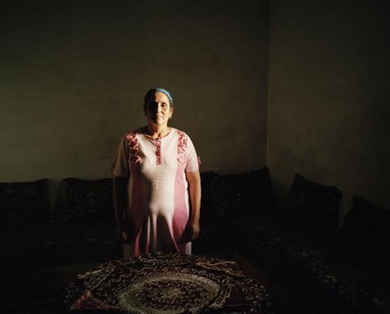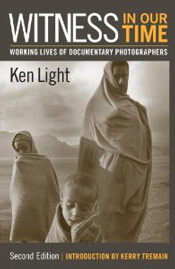Other Recently- Added Exhibits
|

James Loveday
"Dumped" in Guatemala City
Dumped is an essay about the garbage dump in the centre of Guatemala
City. It features the people that live and work there, the appalling
conditions they endure.
|
|
|
SPOTLIGHT/ September 3, 2010
Untangling Threads
Female Artisans in Morocco's Rug Weaving Indus
Photographs by Anna Beecke
Photo by Anna Beecke. Fadma, an older weaver from the Ait Hamza weaving cooperative.  |
In Morocco, where men are responsible for almost all of their country's artisanal production, women have maintained the age-old craft of indigenous weaving.
This project seeks to document the environment and culture of female weavers who have recently begun to participate in local and global markets. It specifically focuses on artisans from three rural weaving communities: Ain Leuh, Ait Hamza, and Taznakht.
While the carpets are generally sold for high-dollar amounts, the female artisans have traditionally received a very small percentage of the profits. This has perpetuated the cycle of poverty and child labor in rural Morocco.
The weaving cooperatives documented in this project are now self-promoting and making direct sales rather than relying on middlemen to distribute their carpets. These photographs aim to highlight the faces behind the production and the market forces that bring these products to the world.
Click here to view the exhibit.
|
The Renewable Project
Photographs by Shuli Hallak
Photo by Shuli Hallak. Oil Refinery, Gulf Coast, Louisiana.  |
Energy fuels our lives, our work, our globally intertwined economy, our collective We. We can not live without the network of systems providing our energy: coal, oil, gas.
We also cannot continue to live with these same systems. It is no longer sustainable. Populations are growing, new energy-hungry middle classes in developing nations are growing, coal and oil are becoming ever more hard to reach, and the collective sum of these factors is contributing to hazardous climate change.
In order for us to move forward collectively, we must see and understand what our options are.
The Renewable Project seeks to show us various forms of energy with a focus on renewables like solar power and geothermal power. These are juxtaposed with fossil based fuel sources like coal and oil.
Click here to view the exhibit.
|
Health Workers on a Shoestring
Health Alliance International, Mozambique
Photographs by Wendy Johnson
Photo by Wendy Johnson. A woman in labor at the Dakata clinic.  |
The worldwide shortage of health workers is most severe in the poorest countries with the greatest burden of disease. Currently there are 2.4 million too few doctors, nurses and midwives to provide essential primary care. The problem is most severe in Sub-Saharan Africa.
Countries like Mozambique have only one doctor and three nurses for every 10,000 people. It's as if the city of Seattle had only 17 doctors. In rural areas, it's not uncommon for a hospital that serves a district of 100,000 or more to be staffed by a single doctor.
Poor countries also subsidize wealthier nations when their highly trained doctors and nurses emigrate because of low salaries and poor working conditions in their home countries. Solving the problems of the "brain drain" and shortage of health care workers in countries devastated by epidemics of HIV, malaria and tuberculosis is critical if we are to achieve further advances in global health and reach the Millennium Development Goals.
Click here to view the exhibit. |

Witness in Our Time, Second Edition, by Ken Light Now Available from Smithsonian Books
 Being a documentary photographer requires great knowledge, perseverance,
understanding and patience. Documentary photographers must capture
informative images that show-and-tell an in-depth story of often
overlooked communities and issues without misleading viewers.
Documentary Photography is an important aspect to news media that
permits newspaper, book, magazine and online viewers to live in the
moment through the power of the photograph. These images are effective
forms of communication that convey meaningful, powerful and historical
evidence of a moment in time and allow the audience to become more aware
of a particular society and its people. More... Being a documentary photographer requires great knowledge, perseverance,
understanding and patience. Documentary photographers must capture
informative images that show-and-tell an in-depth story of often
overlooked communities and issues without misleading viewers.
Documentary Photography is an important aspect to news media that
permits newspaper, book, magazine and online viewers to live in the
moment through the power of the photograph. These images are effective
forms of communication that convey meaningful, powerful and historical
evidence of a moment in time and allow the audience to become more aware
of a particular society and its people. More...
|
Center for Cuban Studies Art Space to Exhibit Work by Constantino Arias and Founder, Lee Lockwood.
231 West 29th Street, 4th Floor
New York, NY
Photograph by Constantino Arias  |
Constantino Arias (1920-1991)
was a freelance photographer whose photos provide a rare, and what is probably
the most complete, black and white picture of Havana society in the 1940s and
50s.
The
Center will also pay homage to its founder, photojournalist Lee Lockwood, who
died July 31 at the age of 78. Lee began photographing the Cuban Revolution
from the first day, January 1, 1959, and the 20 photographs the Center will show
from its extensive collection of his work continue Cuba's story from where
Arias leaves off. The photographs are from the first decade of the Cuban
Revolution.
For more information, contact:
Sandra Levinson
212.242.0559 or slevinson@cubanartspace.net
www.cubanartspace.net
|
About SocialDocumentary.net
SocialDocumentary.net
is a website for photographers, NGOs, journalists, editors, and
students to create and explore documentary websites investigating
critical issues facing the world today. Recent exhibits have explored
oil workers in the Niger River Delta, male sex workers in India,
Central American immigrant women during their journey north, and Iraqi
and Afghan refugees in Greece. Click here to view all of the exhibits.
|
|
|